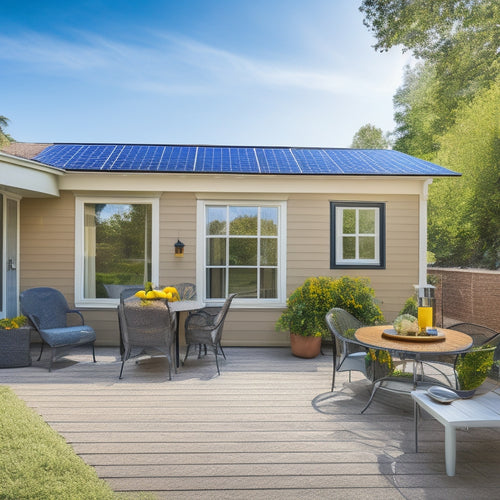
Off Grid Solar Kit for Home Requirements
Share
When designing an off-grid solar kit for your home, you'll need to take into account several essential components to guarantee reliable performance. Start by determining your daily energy usage to size your battery bank appropriately, factoring in depth of discharge and days of autonomy. Select the right charge controller and inverter for your system, prioritizing efficiency and compatibility. Mounting and wiring configurations are also vital, with safety standards and voltage drop minimization in mind. Finally, plan for regular monitoring and maintenance to optimize system performance. As you maneuver through these key requirements, you'll be well on your way to creating a customized off-grid solar solution that meets your specific energy needs.
Key Takeaways
- Determine daily energy usage in watt-hours to calculate required battery bank capacity for off-grid solar kits.
- Choose the right solar panel type, mounting system, and inverter based on energy needs, roof size, and budget constraints.
- Select an efficient charge controller that matches the solar panel array's voltage and current output for optimal energy harvesting.
- Consider the number of days of autonomy needed during low sunlight periods to ensure sufficient battery capacity for off-grid power.
- Ensure proper system sizing, wiring, and grounding to meet safety standards and prevent electrical hazards.
Solar Panel System Requirements
Five key components make up a solar panel system, and each plays an essential role in generating electricity for your off-grid home.
You'll need to select the right solar panel type for your system, as it directly affects energy efficiency. Monocrystalline and polycrystalline solar panels are popular options, with monocrystalline offering higher efficiency rates.
The mounting system secures your panels to your roof or ground, ensuring optimum angle and direction for maximum energy production.
You'll also need an inverter to convert DC power from your solar panels to AC power for your home. Look for an inverter with high efficiency ratings to minimize energy loss.
A charge controller regulates the flow of energy from your solar panels to your battery bank, preventing overcharging or undercharging.
Finally, a monitoring system allows you to track your energy production and consumption in real-time, helping you optimize your system's performance.
Battery Bank Capacity Needs
Once you've selected the right solar panel system, it's time to reflect on the energy storage component: your battery bank. This critical component guarantees a steady supply of power when the sun isn't shining.
To determine your battery bank capacity needs, you'll need to take into account several factors.
-
Daily energy usage: Calculate your daily energy consumption in watt-hours (Wh) to determine the required battery capacity.
-
Depth of discharge (DOD): Decide on an acceptable DOD, which affects the battery's lifespan and overall energy efficiency.
-
Number of days of autonomy: Determine how many days you want your system to provide power during periods of low sunlight or system downtime.
-
Battery type and chemistry: Choose a battery type that suits your needs, such as lead-acid, lithium-ion, or saltwater batteries, each with its own energy efficiency characteristics.
-
System voltage and battery configuration: Decide on the system voltage and battery configuration to guarantee compatibility and ideal performance.
Charge Controller Selection Guide
Your off-grid solar kit's charge controller plays an essential role in regulating the energy flow from your solar panels to your battery bank, guaranteeing safe and efficient charging. This vital component prevents overcharging, which can damage your batteries, and undercharging, which can reduce their lifespan.
When selecting a charge controller, you'll need to take into account the type and features that suit your system's requirements.
There are two primary charge controller types: MPPT (Maximum Power Point Tracking) and PWM (Pulse Width Modulation). MPPT controllers are more efficient, especially in partial shading conditions, while PWM controllers are more cost-effective.
You should also take into account the charge controller features, such as maximum power point tracking, battery temperature sensing, and low voltage disconnect. Additionally, think about the controller's voltage and current ratings, which must match your solar panel array's voltage and current output.
Choose a charge controller with built-in monitoring capabilities, such as LCD displays or communication protocols, to guarantee real-time system monitoring and troubleshooting.
Inverter Sizing for Homes
Selecting the right inverter size for your off-grid solar kit is crucial to guarantee your home receives a steady and reliable power supply.
When choosing an inverter, you'll need to evaluate your home's power requirements, as an undersized inverter can lead to power outages, while an oversized one can be a waste of resources.
Some key factors to evaluate when sizing your inverter include:
-
Peak power demand: Calculate the maximum power your home requires during peak usage hours.
-
Inverter types: Decide between pure sine wave, modified sine wave, or square wave inverters, each with their own efficiency and compatibility considerations.
-
Inverter efficiency: Look for inverters with high efficiency ratings (e.g., 95% or higher) to minimize energy losses and maximize your solar kit's output.
-
DC-to-AC conversion: Confirm your inverter can handle the DC power output from your solar panels and convert it efficiently to AC power for your home.
-
Future expansion: Evaluate an inverter with a higher capacity than your current needs, in case you plan to add more solar panels or appliances in the future.
Mounting and Wiring Considerations
When designing your off-grid solar kit, you'll need to evaluate the ideal mounting options for your solar panels, factoring in aspects like roof size, orientation, and structural integrity.
You'll also need to ascertain your solar panel wiring is properly sized and configured to handle the electrical output, minimizing energy losses and guaranteeing safe operation.
Mounting Options Explained
This off-grid solar kit's mounting system is a critical component, as it directly affects the system's overall efficiency and durability.
You need to choose the right mounting option to guarantee your system performs at its best and lasts for years to come.
When it comes to mounting options, you have several choices:
-
Ground Mount: Ideal for larger systems or where roof space is limited. Ground mounts can be fixed-tilt or tracking, allowing you to adjust the angle and orientation of your panels for maximum energy production.
-
Roof Mount: Suitable for most residential installations. Roof mounts are designed to withstand various weather conditions and can be flush-mounted or tilted to accommodate different roof types.
-
Pole Mount: A versatile option for smaller systems or where a traditional ground mount isn't feasible. Pole mounts can be fixed or tracking, and are often used for smaller installations.
-
Tracking Mount: Maximizes energy production by adjusting the panel angle and orientation to follow the sun's movement.
-
Adjustable Mount: Allows you to adjust the tilt and angle of your panels seasonally to enhance energy production.
Solar Panel Wiring Essentials
Configuring your off-grid solar kit's electrical connections is an essential step in guaranteeing a safe, efficient, and reliable system. You'll need to take into account the type of solar panels you're using, as different types have varying voltage and current outputs. Monocrystalline and polycrystalline panels, for instance, typically operate at higher voltages than thin-film panels.
Confirm your wiring can handle the maximum power output of your panels to avoid overheating and electrical shock.
Wiring safety is critical. Use weather-resistant, UV-stabilized wiring and connectors rated for outdoor use. Keep wiring runs as short as possible to minimize voltage drop and energy loss. Use fuses or circuit breakers to protect your system from overcurrents and short circuits.
Ground your system to prevent electrical shock and provide fault protection. Follow industry standards and local electrical codes to verify your system meets safety requirements.
Proper wiring will guarantee your off-grid solar kit operates efficiently and safely, providing you with reliable power when you need it.
Monitoring and Maintenance Needs
Regularly, your off-grid solar kit requires attention to guarantee peak performance and longevity.
As you're invested in utilizing renewable energy, you want to confirm your system operates at its best. Monitoring and maintenance are vital aspects of off-grid solar kit ownership, allowing you to identify potential issues before they become major problems.
To keep your system running smoothly, you'll need to:
- Check the system's performance regularly, looking for signs of malfunction or underperformance
- Inspect the solar panels and mounting structure for damage or debris
- Verify the charge controller and inverter are functioning correctly
- Monitor the battery bank's state of charge and overall health
- Develop troubleshooting techniques to quickly identify and address any issues that arise
Frequently Asked Questions
Can I Use an Off-Grid Solar Kit for My RV or Boat?
You can definitely use an off-grid solar kit for your RV or boat, as RV solar and boat solar systems provide reliable power on-the-go, but consider your specific energy needs, battery capacity, and panels' durability for peak performance.
Do I Need to Install a Separate Grounding System for My Solar Panels?
You'll need to guarantee your solar panel installation meets safety standards by incorporating proper grounding techniques, such as a grounding rod and busbar, as part of your safety measures to prevent electrical shock and fire hazards.
Can I Add More Solar Panels to My Existing Off-Grid System Later?
You can add more solar panels to your existing off-grid system later, but make certain the new panels match the existing system's voltage and connector type for seamless solar panel expansion and system compatibility.
Are Off-Grid Solar Kits Compatible With Lithium-Ion Batteries?
You'll be pleased to know that most off-grid solar kits are designed to be compatible with lithium-ion batteries, ensuring ideal battery compatibility and solar efficiency, allowing you to maximize your energy harvesting and storage capabilities.
Do I Need a License to Install an Off-Grid Solar Kit in My Home?
You'll likely need installation permits, so research local regulations before installing an off-grid solar kit in your home, as requirements vary by region and municipality, ensuring a smooth, compliant, and safe shift to renewable energy.
Related Posts
-

10 Tips to Buy Affordable Solar Panels Online
When purchasing affordable solar panels online, you'll want to research reputable retailers, compare prices, and chec...
-

What Are the Average Cost Savings of Solar Panels
You can expect to save between $400 and $1,000 per year on your electricity bills with solar panels, which translates...
-

Best Solar Panel Options for Maximum Energy Savings
You can maximize your energy savings with solar panels that boast efficiency ratings above 20%, paired with extensive...


